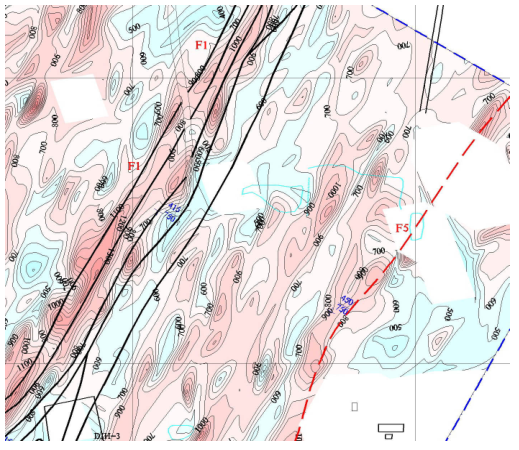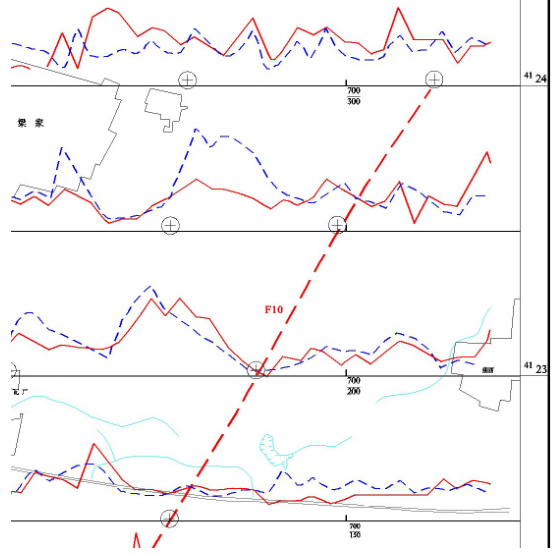Application of Geophysical Methods to Gold Prospecting
Abstract. In this study, based on analyzing previous geological data, some geophysical methods, such as high magnetic measurement, DC resistivity combined profiles, induced polarization (IP) survey, were applied to constrain the distributions of the stratum, structure and magmatic rocks as well as ore-controlling factors in the Loulitou district, Jiaodong Peninsula. Finally, the interpretation of surface and underground IP data were used to guide ground prospecting. Through above geophysical work, several possible favorable abnomal locations for concentration of ore-bearing sulfides were distinguished and several locations for gold prospecting were verified by drilling.
Keywords: Oe-controlling factors, Gophysical methods, Gold prospecting.
Introduction
The Loulitou district is located in the middle part of Zhaoyuan-Pingdu fault, which provides a good target for further prospecting and exploration. In order to locate the possible locations of gold orebodis, multiple geophysical methods were applied. Firstly, IP intermediate gradient measurements were carried out in the Houtuan and Banbidian districts, and initial targets were proposed. Then, high precision magnetic survey was done for the targets.
The Zhaoyuan-Pingdu fault is located in the northwestern part of Jiaodong Peninsula along the southeast North China Craton [1,2] . The Jiaodong group, which is mainly consist of amphibolite plagioclase and biotite granulite, is unconformably overlain by the Paleoproterozoic ultramafic rocks, granulite, amphibolite, marbles, and schists. The Qixia super-unit was transformed by regional metamorphic and deformed processes, thus formed lineation roughly in east-west direction. Gneissic or weak gneissic schistosity was formed in the Linglong super-unit due to the transformation by regional deformation. With the superimposition of brittle fracture in different azimuth since Menozoic, the tectonic framework characterized by brittle–ductile structures intersection formed in regional scale.
The gold deposits in Jiaodong Peninsula are classified as orogenic gold deposits [3] . Gold mineralization is strictly controlled by regional NE-NNE faults, including the Sanshandao, Jiaojia, Zhaoyuan-Pingdu and Qixia faults stretch successively, and nearly 90% of the gold resources are located along these faults. Among of these faults, the Zhaoyuan-Pingdu fault was firstly discovered. Benefits from the special gold mineralization conditions, gold resource of more than 1500 tons were proven here. The gold belt is apparently waved bended along the strike with overall trend of 50° and dips to south east with dip angle of about 50°, respectively. Wide altered cataclastic rock is distributed along Zhaoyuan-Pingdu fault. The fault controls different sizes of gold deposits such as the world-class Linglong, Taishang, Fushan, Jiuqu, Dayingezhuang, Xiadian, and Jiudian and a series of Au occurrences and mineralized spots [4] .
Regional intrusive rocks are widely distributed and strongly controlled by the Zhaoyuan-Pingdu fault. Wallrock alterations are usually developed along the fault, and the nature, size and activity duration of structure determine the types and strength of alteration. Major alterations include potash feldspathization, sericitization, silicification, pyritization, carbonatization, polymetallic sulfide mineralized, kaolinization, and chloritization [5] .
Structure zones control the alteration and mineralization zones, hence regular mineralization and alteration patterns formed [4] . The distributions of orebodies in these deposits are generally controlled by faults and fractures of different scales. The controlling effects on orebodies vary with depth, themain ore-controlling structures control the distribution of altered belt, and secondary structures determine the specific positions of orebodies, shapes and partial enrichment in shallow depth. With the increase of depth, the effects of shallow brittle secondary ore-control ling structures gradually reduce.
Theory and Methods
The rocks in this district show obvious differences between magnetism and resistivity. Combing these features and the previous geological data, the occurrences of the stratum, magmatic rocks and faults were located [6] . All kinds of ores in this district have high polarizabilities ranging from 2.44 to 4.04% which are as 5-8 times as that of other rocks. The polarizabilities of metamorphic rocks are about 1% higher than that of magmatic rocks. Given to the obvious differences of polarizabilities between these rocks, the IP intermediate gradient measurement is a proper method to locate the ores.
Firstly, geodetic survey was done before carrying out 1:10000 high-precision magnetic survey and 1:5000 IP intermediate gradient measurement. Five GPS-controlling points and related marks were
set up for further work in the working area. GARMIN eTrex GPS made in the US was used in the high-precision magnetic survey. All the equipments of GPS were checked and debugged based on the known controlling points before carrying out the magnetic survey. The maximum error was less than 0.5m. Signals from seven or more satellites were received showing the best condition (3D model) of the equipment during the survey and providing precise point positioning. Real-time dynamic equipment of Lingrui S80 GPS was used in the IP intermediate gradient measurement. The base stations were set up at known and self-test controlling point. The location and azimuth angle of each mobile station was set up and marked based on surveying lines. The distance between the mobile and base stations should keep in less than 2km during the work.
High magnetic measurements were applied to distinguish lithology and locate the distribution of magmatic rocks and the faults to analyze the ore-controlling factors and possible locations which are favorable for mineralization [7] . Area of 48.0km 2 was surveyed with nets of 100m×20m and azimuth angle of 90° using WCZ-1 type proton magnetometer. The measurement parameter is geomagnetic total field "T". Ruptures were inferred by high resistance anomaly zone in the working area (figure 1).

Figure 1. Sketch map of ruptures inferred by high resistance anomaly zone.
DC resistivity combined profiles method, which is based on the differences of resistivity of hosting rocks and ores, is used to investigate the spatial variety of the resistivity. In turn, the spatial variety of the resistivity can be used to constrain the distribution of the ore-controlling structures [8] . The infinite electrode of the instrumentation used in working was laid perpendicular to the line and the distance was not less than 1000m. WDJD-3 type intensification-polarization instrument with length of AO of 175m and dot pitch of MN of 50m was used in the survey. The equipment was powered by several batteries of 45V providing power up to 270V. All pole pitches, the characteristics of the curves, distortion and the potential difference of which was below the mark, were observed repeatly until they were qualified, then following works were started. Based on the previous work experience and geological conditions of the region, the parameters of IP intermediate gradient were set up as (1) the length of AB of 1200m, (2) the dot pitch of MN of 20m and (3) the maximum side measure distance of 200m. The other equipment used in the survey included WDJS - 2 type digital Dc IP receiver, WDFZ-10 type high-power intelligent transmitter, WDZ-10 type rectifier power and generator with capacity of 10KW. Bipolar short pulse mode with discharge time of 4s×4s was used during the power supplying. For three cycles, the delay and integral were set up as 100ms. Rupture was inferred by orthogonal points of DC resistivity combined profiles in the working area (figure 2).

Figure 2. Sketch map of rupture inferred by orthogonal points of DC resistivity combined profiles.
Several locations of anomaly were distinguished based on the work state above. For these areas, in order to investigate the distribution of the fault plane and the polarization bodies as well as the occurrence and extension of the ores, further measurement of IP combined profiles with AO=110m or 190m and MN=20m, and IP sounding method was carried out [9] . The distance of infinity pole was five times as AO. The other equipment and power was as same as IP intermediate gradient ladder. Non-uniform Quadrupole devices were used in the survey. The orientation of electrode was parallel to the survey lines. The maximum AB/2 distance is 1000 m. In order to search the extension of well-known and blind orebodies, in-hole IP surveying was carried out [10] . Surface power and double polarity short pulse mode were used during the surveying. Finally, the interpretation of surface and underground IP data were used to guide ground prospecting.
Conclusions
The geological characteristics of middle part of Zhaoyuan-Pingdu fault (F 1 ) were further constrained by the geophysical work.
1. Combing the geological data and results from high-precision magnetic measurement and IP survey, the distributions of the monzonitic granite and the metamorphic and deformed intrusive body were confirmed, and the Zhaoyuan-Pingdu fault covered by sediment was located.
2. The distributions of the residual metamorphic rocks and serpentinite were constrained. Several magmatic rocks intruded in the different period. The difference of magmatism and tectonic movements were beneficial to the enrichment of metallogenic material. The intrusions were chartered by magnetic granite which was connected to the concealed granite within the eastern area.
3. Based on comprehensive analysis and study, fifteen faults including theF 1 were distinguished. Nine of these faults were inferred from the new geophysical data. Most of the faults are NE-NNE-trending. The generated sequence of fracture structures was: NE- (associated NW-), NW-, NNE- (associated NW-, and NE- resurrection fracture), E-trending faults. It was the middle part of F 1 that exposed in the area. It develops along the contact zone between the Linglong (footwall) and Qixia super units (hanging wall) with variable trending and dipping. On the footwall of F 1 , some NNE-NE-trending faults developed and controlled several small scale of gold deposits.
4. In this study, four IP anomalies (DJH–1 to DJH–4), where further IP combined profiles and sounding were done, were distinguished. Two of these anomalies (DJH-1 and DJH-3) were
investigated by drilling. Weak gold mineralization with grade of 0.98g/t and high anomalies of ηa were found at -207m of the drill hole ZK0801 and -300m of ZK0803. Based on these results and principle of IP as well as working experience in the area, the two IP anomalies (DJH-1 and DJH-3) may be caused by the enrichment of steeply dipping (70°-80°) sulfides on the footwall of F 1 . Because the south part of the DJH-2 anomaly is not enclosed, further work need to be done. The DJH-4 anomaly is located in the monzonitic granite.
5. The prospecting and exploration of the gold orebodies along F 1 was stuck for many years. This study provided good geological and geophysical data for further breakthrough of prospecting and exploration. Furthermore, geological and geophysical prospecting model, which could be used in the whole area and other similar areas, were built based on the characters of known gold deposits [11] .

